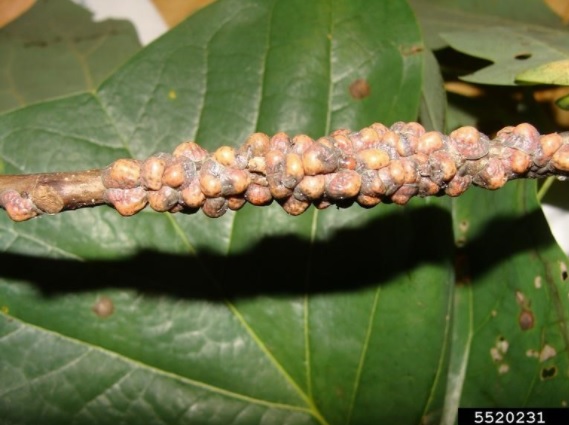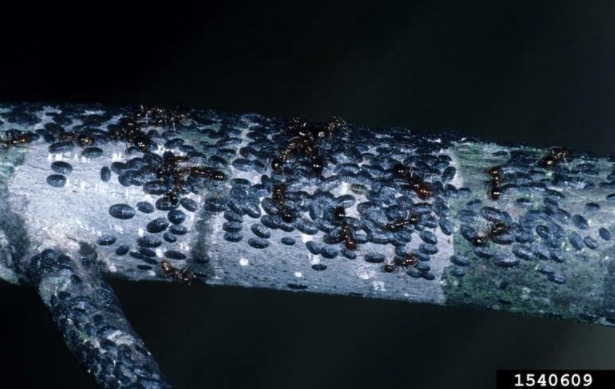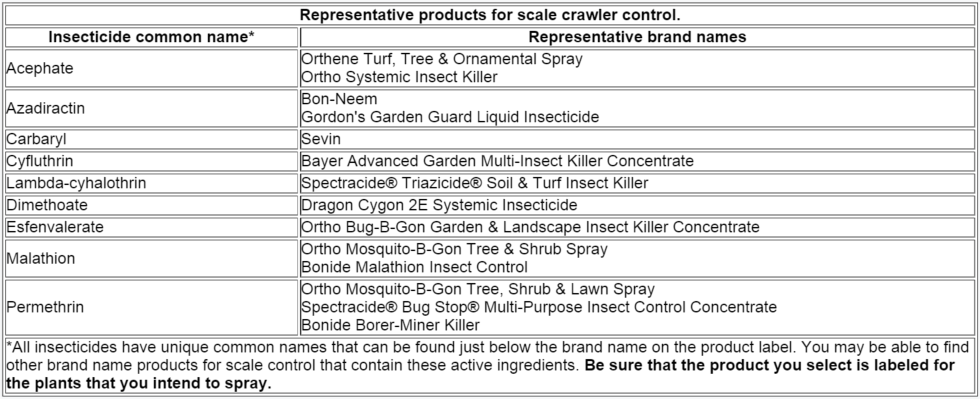Tuliptree Scale
ENTFACT-435: Managing Tuliptree Scale | Download PDF
By Jonathan L. Larson, Extension Entomologist and Lee Townsend, Extension Specialist Emeritus
Tuliptree Scale Fast Facts:
-
Tuliptree scale is a large soft scale species that can infest poplar, magnolia, tulip poplar, and other landscape trees.
-
As female tuliptree scales mature they become spherical and can cause limbs to appear warty. They also produce large amounts of honeydew and attract black sooty mold.
-
Management can depend on using a dormant oil in the winter to control overwintering immature scales, the use of targeted insecticides application to control crawlers when they emerge, or through the use of a systemic product.

Mature tuliptree scales can be large and puffy in appearance, which gives infested trees a warty appearance. Photo by Eric R. Day, Virginia Polytechnic Institute and State University, Bugwood.org
Potential Hosts
Tuliptree scale has been found to attack poplar, tulip poplar, linden, redbud, and magnolia trees.
Symptoms and Pest Description
Scale insects are “sucking pests”, meaning they use a needle like mouth to siphon fluids from plants. Tuliptree scales are part of the “soft scale” group, meaning that they do not produce a waxy shield that covers their body. Soft scales are known for their ability to produce large amounts of honeydew. Since these insects are processing/feeding on sugary sap all day, they also defecate out this sugar water-like substance. Accumulations of honeydew are shiny and sticky and may also recruit black sooty mold fungus which feeds on honeydew and may cover branches and trunks. Scale feeding can also induce thinning of the canopy and twig dieback.
A mature female tuliptree scale is 3/8" long and can be grey, yellow, orange, or pink black in color. Immature scales of this species have a conspicuous black coloration. These soft scales will also have a raised profile, with a slightly spherical shape. Because of this, infestations of tuliptree scale often give the twigs of the tree a warty, bumpy appearance.
Life Cycle in Kentucky
Tuliptree scales overwinter as immature scales. These immature scales will resume their feeding and development the year after they were born and will complete their growth by summer. Males will mature into winged insects that mate with immobile females. Each female tuliptree scale can produce up to 3000 new scales. The eggs hatch around August and new crawlers will either settle on the same tree as their parents or may be dispersed by the wind or birds. The new generation will feed for a short time before overwintering. There is one generation each year.

Tuliptree scale overwinters as an immature nymph that will complete its development the next growing season. These immatures have a dark black coloration. Lacy L. Hyche, Auburn University, Bugwood.org
Management
Scales tend to thrive on stressed plants. Following a recommended fertility program and watering regime will promote plant health. However, over-fertilization favors scale buildup. If practical, improve plant sites to reduce stress and promote growth. You can prune out small infestations to try and eliminate the issue or prune out sections of a large scale problem in order to make chemical control more feasible.
There are two insecticide options when considering management of scales, doing a systemic treatment or treating the crawlers directly. Whichever you choose, management may take repeated applications over a couple of growing seasons.
Treating with Systemic Insecticides
When dealing with soft scale species such as the tuliptree scale, you can use a systemic treatment of imidacloprid (Bayer Tree & Shrub is one possible trade name) or dinotefuran (Orthro Tree & Shrub is one possible trade name). A systemic insecticide helps to give you control without reliance on broadcast sprays on the plant. This helps keep insecticide residues contained within the plant you wish to protect and helps to ensure the product will affect the pests you are targeting. Timing is important when choosing to use a systemic product though. A springtime application (April-May) should provide 12 months of management.
Treating Crawlers Directly
Crawlers are the most susceptible to control stage of a scale insect’s life. In order to treat the crawlers, you should be monitoring for their emergence. You can visually check in August for tuliptree scale crawlers. Alternatively, you can place pieces of black electrical tape (sticky side out) or double-sided tape near scale populations and monitor the tape for the crawlers and treat following the initial find.
Horticultural oils kill by suffocation or after penetrating over-wintering stages of the insect. Consequently, they may not be effective where several layers of scales have accumulated. Insecticidal soaps are long chain fatty acids that kill susceptible insects through direct contact. Like horticultural oils, they require thorough coverage. Soaps leave no residue so repeated applications may be needed for some pests. These products may burn the foliage of sensitive plants, such as Japanese maple, so check the label for information about the plant species that you intend to treat.
Dormant oils are products applied when the tree is in its dormant season. If they are applied to green plant tissue they will burn the plant as well as control pests. Dormant oils can be applied in the winter to tuliptree scales to control the nymphs.
A variety of natural and synthetic insecticides are labeled for use as sprays to control scale crawlers on landscape trees and shrubs. While the residual life of these products is generally longer than oils and soaps, timing, coverage, and precautions on damage to some plant species are very similar to those for oils and soaps.
Below are some options for scale insect crawler control.

Evaluating Control
The success or failure of control efforts may not be readily apparent but here are some things to check.
-
Live scales should produce a liquid when mashed, dead scales will be dry and not "bleed" when crushed.
-
New foliage should have a healthier appearance once the scale burden has been removed. Buds should break a little earlier than when the plant was infested and expanded leaves should have normal color and turgor.
Revised: 2/2021
CAUTION! Pesticide recommendations in this publication are registered for use in Kentucky, USA ONLY! The use of some products may not be legal in your state or country. Please check with your local county agent or regulatory official before using any pesticide mentioned in this publication.
Of course, ALWAYS READ AND FOLLOW LABEL DIRECTIONS FOR SAFE USE OF ANY PESTICIDE!
Images: University of Kentucky Entomology and Bugwood.org
